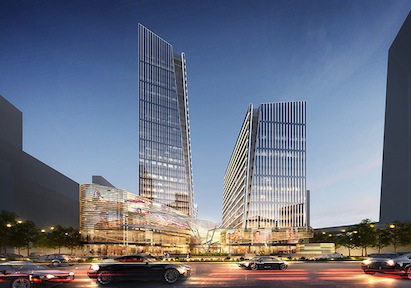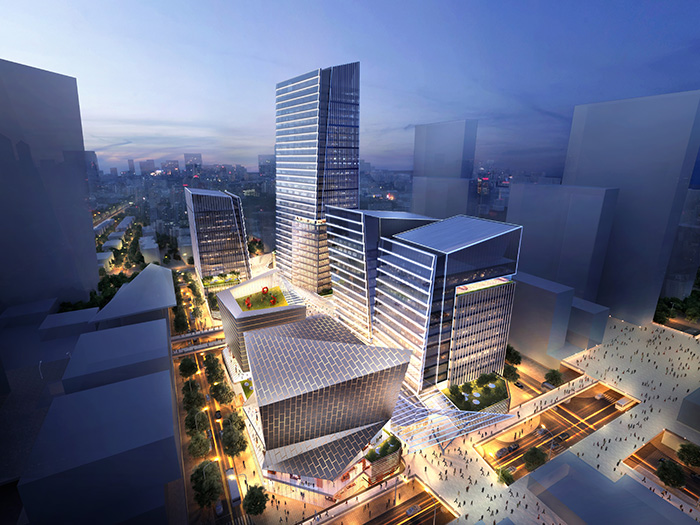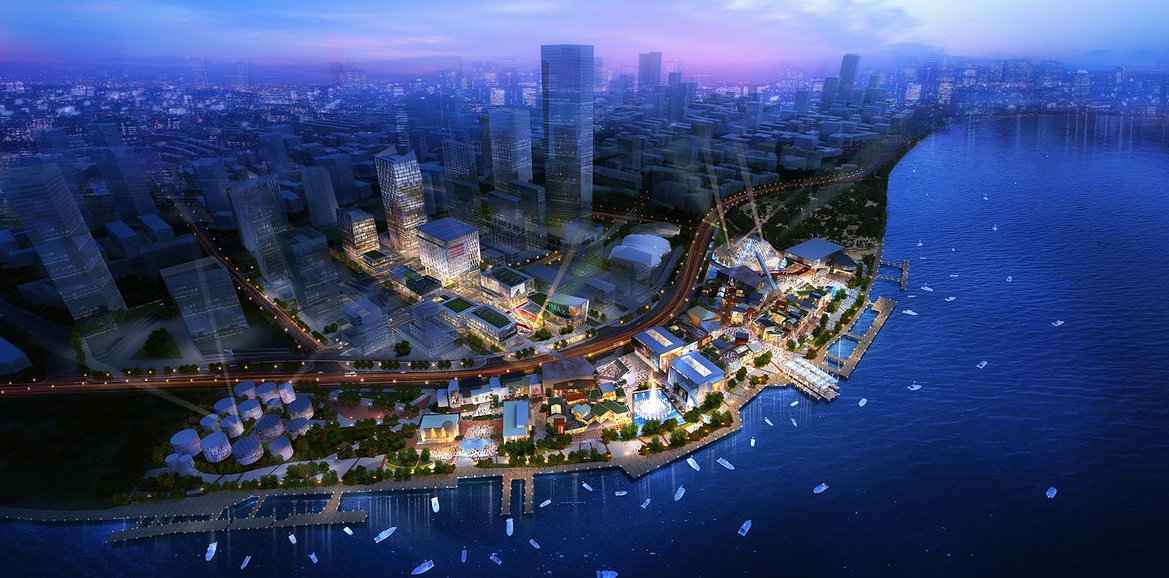International architecture firm Kohn Pedersen Fox Associates (KPF) is pleased to unveil designs for DreamWorks Asia Headquarters, Oriental Dreamworks and creative offices in the new Shanghai DreamCenter, which constitutes one of the most exciting projects in China.
Located along the riverside in Xuhui District, the 463,000-square-meter DreamCenter is an integrated cultural and lifestyle landmark that will feature performing arts spaces, creative media spaces, black box and imax theaters, as well as world-class entertainment, fashionable retail areas and premium restaurants and bars.
“Together with the West Bund Media Port, this will become the world’s third great urban center for entertainment and arts alongside New York’s Broadway and London’s West End,” said DreamWorks Animation CEO Jeffrey Katzenberg. With offices on New York’s 42nd Street and in London’s Covent Garden, KPF is quite literally ‘in’ show business and has come to know what makes such creative capitals tick. In the words of KPF Principal Paul Katz, “We also know first-hand the value of locating in such creative cores, for our process, our staff, and our work as architects.”
A collaboration between Hong Kong Lan Kwai Fong Group, DreamWorks Animation and Shanghai China Media Capital, the DreamCenter is the flagship project of Shanghai’s West Bund Media Port, a large-scale development focused on creative and digital media, technology, and cultural industries.
Katz commented, “We’ve watched Shanghai develop into a global city. And now, three visionaries, three of the most influential shapers of global culture in the 21st century are coming together to create its creative hub: Jeffrey Katzenberg, who heads one of the most influential studios in the industry; Allan Zeman, who has made such a huge contribution to Hong Kong, including the development of Lan Kwai Fong in HK and now China, which transformed the culture of public space and demonstrated a new respect for international lifestyle and world-class entertainment; and Li Ruigang, the visionary who has punctuated the evolution of China’s media and entertainment industry. In 20 years, Shanghai has transformed itself from an agrarian-based economy to one of the leading post-industrial economies in Asia. The DreamCenter project will further define Shanghai’s role as a global meeting-place for creative industry, technology, entertainment, and culture.”
Through the revitalization of the hundred-year-old former cement factory and other industrial artifacts into iconic creative live performance venues and F&B facilities, DreamCenter blends together the site’s industrial and cultural history with modern architecture, offering an unseen experience for the people of Shanghai and international tourists.
KPF’s two-block design represents the creative heart of the master plan—and its largest district. The eastern block is home to a pair of creative office towers, a theater building and arts building, whose open-air rooftop features a sculpture garden. The western block features a pair of towers (DreamCenter’s tallest), which angle slightly as they rise above this space, framing the views westward towards the DreamCenter and Huangpu Riverfront and creating “sky canyons” that capture the sky by day and emanate light and activity by night. At the base of the tower, the design includes a direct connection to the Shanghai Metro, a shared retail podium, and an elevated pedestrian walkway lined with shops and restaurants that extends eastward to connect the entire development.
Like KPF’s designs for Roppongi Hills in Tokyo, Hudson Yards in New York, and Covent Garden in London, Shanghai DreamCenter will become the great gathering place for the city, bringing together diverse activities, industries, and cultures, and enabling this energy and streetlife to radiate outwards, activating the city.
Construction of the Shanghai DreamCenter will begin this year and is expected to complete in 2017.
About Kohn Pedersen Fox Associates (KPF)
Kohn Pedersen Fox Associates (KPF) is one of the world’s pre-eminent architecture firms, providing architecture, interior, programming and masterplanning services for clients in both the public and private sectors. Operating as one firm with six global offices, KPF is led by 24 Principals and 27 Directors. The firm’s 600+ staff members come from 43 different countries, speak more than 30 languages and include over 80 LEED accredited professionals.
KPF’s diverse portfolio, which features over 70 projects certified or pursuing green building certification, comprises corporate, hospitality, residential, academic, civic, transportation and mixed-use projects located in more than 35 countries. The firm’s recent work includes the Abu Dhabi International Airport, the Shanghai World Financial Center, the International Commerce Centre in Hong Kong, New Songdo City in Korea, the Mandarin Oriental Las Vegas, the RBC Centre and Ritz? Carlton in Toronto, and Heron Tower, Sixty London and Unilever House in London.
Related Stories
| Nov 2, 2010
Energy Analysis No Longer a Luxury
Back in the halcyon days of 2006, energy analysis of building design and performance was a luxury. Sure, many forward-thinking AEC firms ran their designs through services such as Autodesk’s Green Building Studio and IES’s Virtual Environment, and some facility managers used Honeywell’s Energy Manager and other monitoring software. Today, however, knowing exactly how much energy your building will produce and use is survival of the fittest as energy costs and green design requirements demand precision.
| Nov 2, 2010
Yudelson: ‘If It Doesn’t Perform, It Can’t Be Green’
Jerry Yudelson, prolific author and veteran green building expert, challenges Building Teams to think big when it comes to controlling energy use and reducing carbon emissions in buildings.
| Nov 2, 2010
Historic changes to commercial building energy codes drive energy efficiency, emissions reductions
Revisions to the commercial section of the 2012 International Energy Conservation Code (IECC) represent the largest single-step efficiency increase in the history of the national, model energy. The changes mean that new and renovated buildings constructed in jurisdictions that follow the 2012 IECC will use 30% less energy than those built to current standards.
| Nov 1, 2010
Sustainable, mixed-income housing to revitalize community
The $41 million Arlington Grove mixed-use development in St. Louis is viewed as a major step in revitalizing the community. Developed by McCormack Baron Salazar with KAI Design & Build (architect, MEP, GC), the project will add 112 new and renovated mixed-income rental units (market rate, low-income, and public housing) totaling 162,000 sf, plus 5,000 sf of commercial/retail space.
| Nov 1, 2010
John Pearce: First thing I tell designers: Do your homework!
John Pearce, FAIA, University Architect at Duke University, Durham, N.C., tells BD+C’s Robert Cassidy about the school’s construction plans and sustainability efforts, how to land work at Duke, and why he’s proceeding with caution when it comes to BIM.
| Nov 1, 2010
Vancouver’s former Olympic Village shoots for Gold
The first tenants of the Millennium Water development in Vancouver, B.C., were Olympic athletes competing in the 2010 Winter Games. Now the former Olympic Village, located on a 17-acre brownfield site, is being transformed into a residential neighborhood targeting LEED ND Gold. The buildings are expected to consume 30-70% less energy than comparable structures.
| Oct 27, 2010
Grid-neutral education complex to serve students, community
MVE Institutional designed the Downtown Educational Complex in Oakland, Calif., to serve as an educational facility, community center, and grid-neutral green building. The 123,000-sf complex, now under construction on a 5.5-acre site in the city’s Lake Merritt neighborhood, will be built in two phases, the first expected to be completed in spring 2012 and the second in fall 2014.
| Oct 21, 2010
GSA confirms new LEED Gold requirement
The General Services Administration has increased its sustainability requirements and now mandates LEED Gold for its projects.
| Oct 18, 2010
World’s first zero-carbon city on track in Abu Dhabi
Masdar City, the world’s only zero-carbon city, is on track to be built in Abu Dhabi, with completion expected as early as 2020. Foster + Partners developed the $22 billion city’s master plan, with Adrian Smith + Gordon Gill Architecture, Aedas, and Lava Architects designing buildings for the project’s first phase, which is on track to be ready for occupancy by 2015.


















